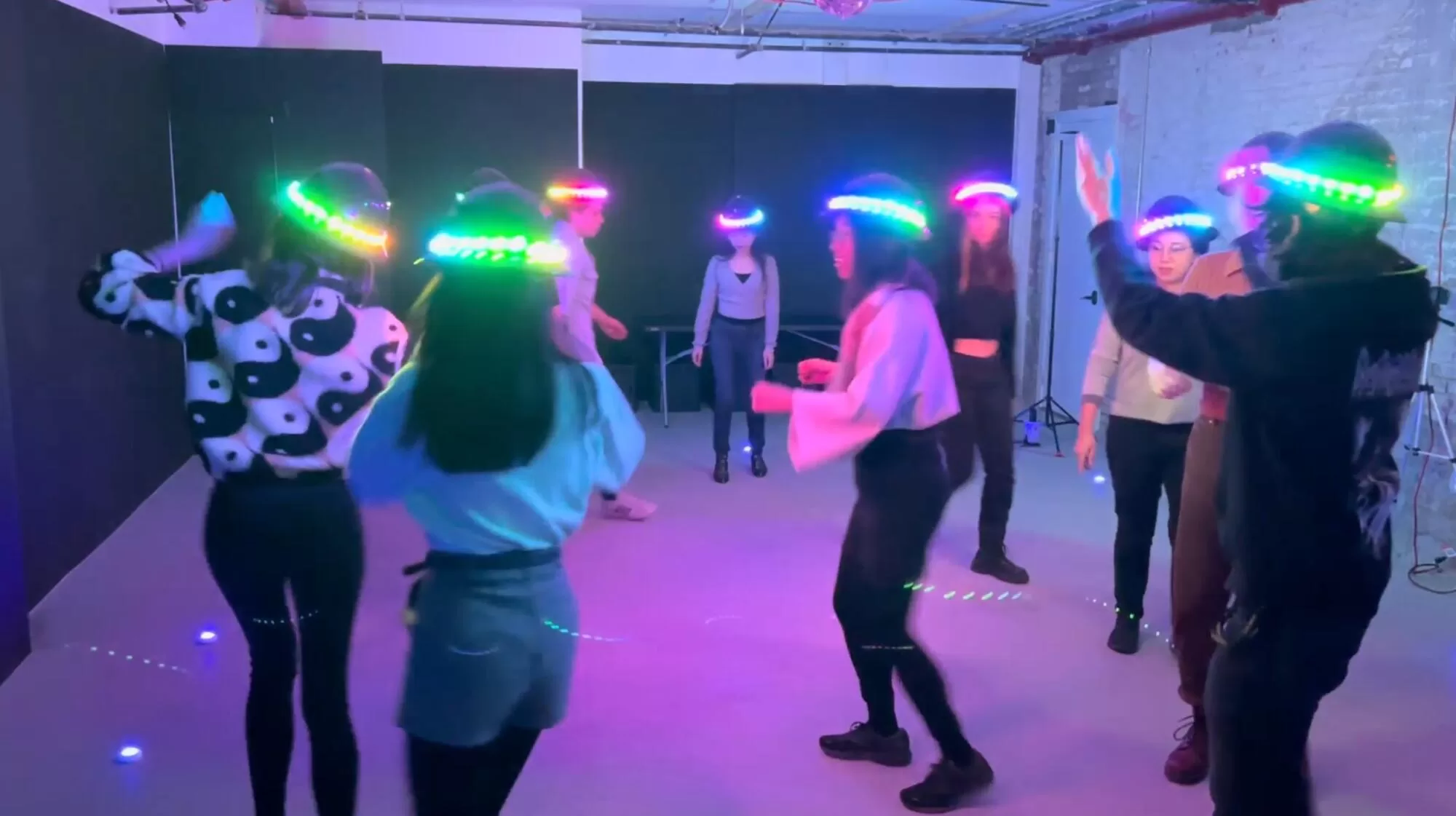The game started as an experiment. A way to look at emergent behavior — the coordinated and mesmerizing flight of a flock of birds, for instance.
For artist and researcher Hillary Leone, the concern was that the world was becoming more divisive. She wanted to create a new language, one that showed the power of cooperation. Teaming with a host of researchers, she wanted to study human communication, to probe how individual actions contributed to collective problem solving.
What, essentially, makes a successful group?
This is “Sync.Live,” and while you don’t need to know the science behind it to play it, doing so adds meaning to the experience of wearing a top hat affixed with blinking LED lights and making silly, exaggerated strides at strangers. The goal: to synchronize the lights on the hats. No talking or touching allowed. And the challenge? You can’t see the lights on your own hat, meaning you must rely on non-verbal cues from others.
“I really want people to feel the thrill of direct human connection,” Leone says.
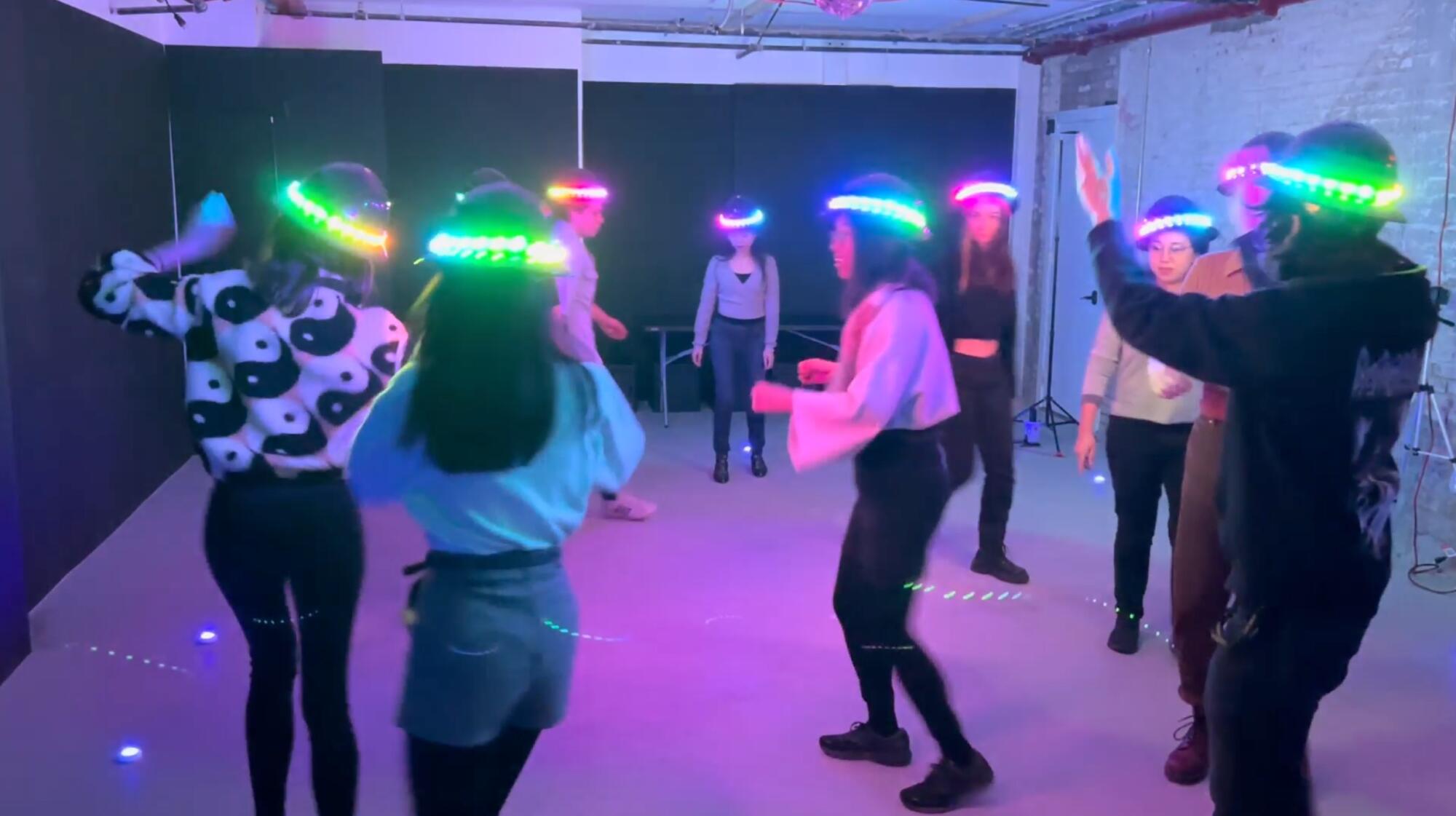
A group of young adults playing “Sync.Live,” which will be showcased at this year’s IndieCade and focuses on non-verbal communication.
(Visions2030 / “Sync.Live”)
“Sync.Live” is part of IndieCade’s long-running free Night Games programming, back for the second year at downtown’s Music Center on Friday and Saturday evenings. IndieCade for more than 15 years has been dedicated to championing independent games, often with a focus on the experimental and the approachable. Think of an IndieCade happening as a showcase for what’s underground, what’s next and what’s important in interactive storytelling, a gathering that takes a wide-angle view to all things play.
For play at an IndieCade event is not just a medium but a language. “‘Sync.Live’ is a cooperative game,” says the Music Center’s Kamal Sinclair, who heads the firm’s Digital Innovation Initiative and brought Night Games to the space, adding that works like “Sync.Live” bridge the gap between games and theater. “It’s a simple game mechanism — people just trying to find patterns together — but the visuals of it, with things on your head and lights changing colors, it does it all. It creates a connection. It creates laughter. You can think about mathematics and patterns. This, to me, is improvisational choreography.”
Night Games will be home to academic experiments — “Sync.Live” — as well as games that ask us to converse and work together via a seesaw, such as the pirate-themed “Back Off Me Booty.” It also makes space for immersive theater — see the whimsical investigative adventure that is “The Apple Avenue Detective Agency” — and even games that turn barcode scanners into controllers, such as “Wizard’s Warehouse: The Magick of Retail.” The latter is group chaos, as we take on the role of shopkeepers in a fairy tale kingdom who are frantically trying to fulfill orders. There are screen-based offerings as well, but the emphasis is often on the communal, as evidenced by the anyone-can-be-an-artist zaniness that is “Sloppy Forgeries.”
Last year’s Night Games drew about 2,000 participants over its two days, says Sinclair. IndieCade makes sense for the theatrical-focused Music Center, Sinclair says, as games not only create a dialogue but turn players into active performers.
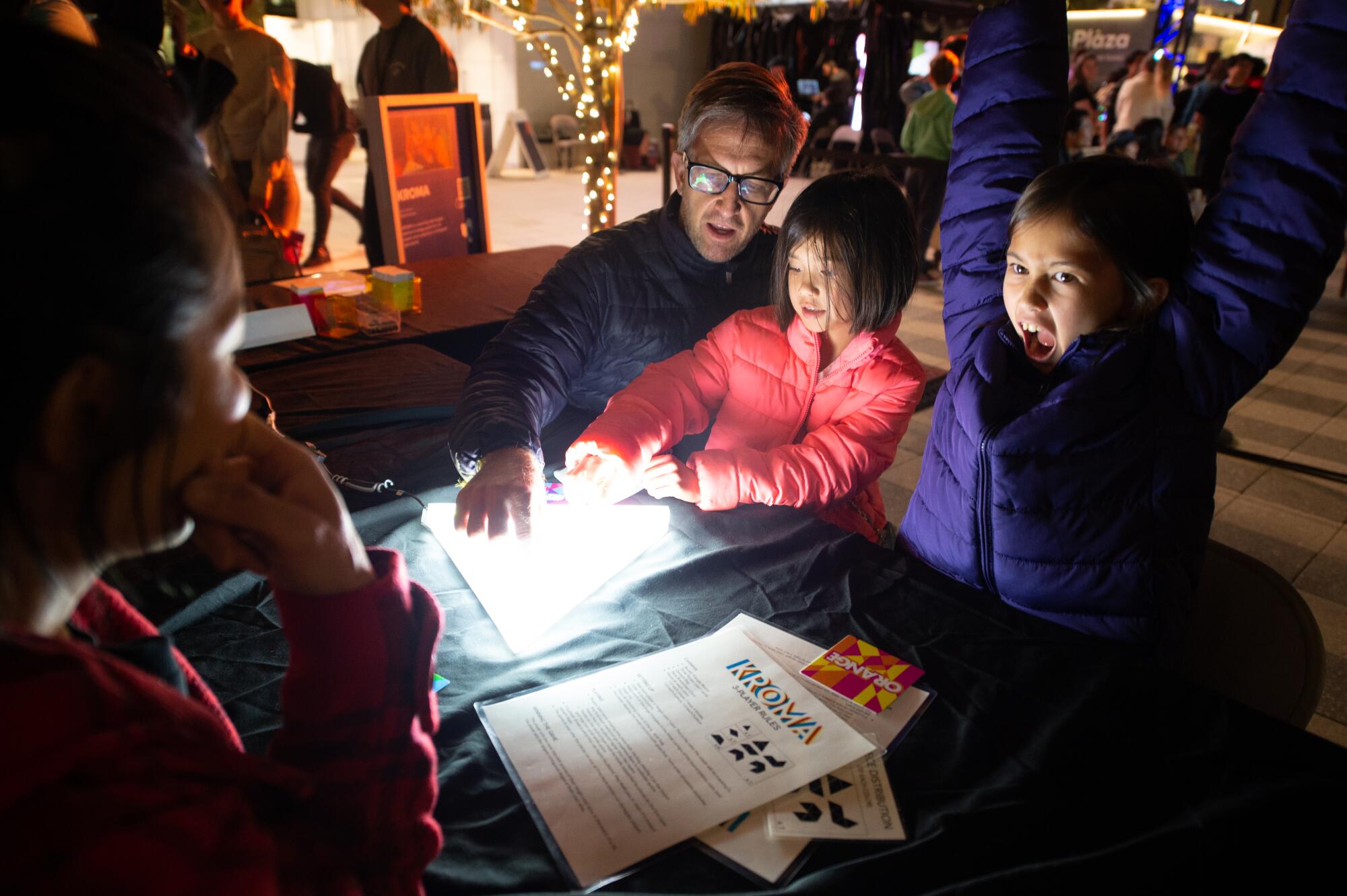
Guests at IndieCade in 2023 play the light-up puzzle game “Kroma.”
(Scott Chamberlin / IndieCade)
“Not to get too academic or philosophical, but in many cultures there’s a participatory relationship with performance,” Sinclair says. “It’s not just watching and sitting in a chair and looking at a stage. With a sense of play, everybody is participating in story and aesthetics and all those good things the arts do for creating meaningful experiences and creating community.”
IndieCade has shifted over the years. In its pre-pandemic incarnation, IndieCade was often a multi-day festival at locations in Santa Monica or Culver City, with game showcases and panel talks. The online nature of the world post-2020, coupled with the difficulty in raising sponsorship funds for a discovery-focused game event, has put most of IndieCade’s offerings, including its annual awards, on the web, but the party-focused celebration that is Night Games has endured.
IndieCade co-founder Stephanie Barish says Night Games typically had the broadest appeal of IndieCade’s in-person offerings. “You’re really able to just be with other people in a real way,” Barish says. “You can be so much more tolerant of people because you’re around people you wouldn’t normally even talk to, but you had a great experience playing with them. It’s just a way of connecting with people that transcends the normal way we connect. I do believe it’s transformative.”
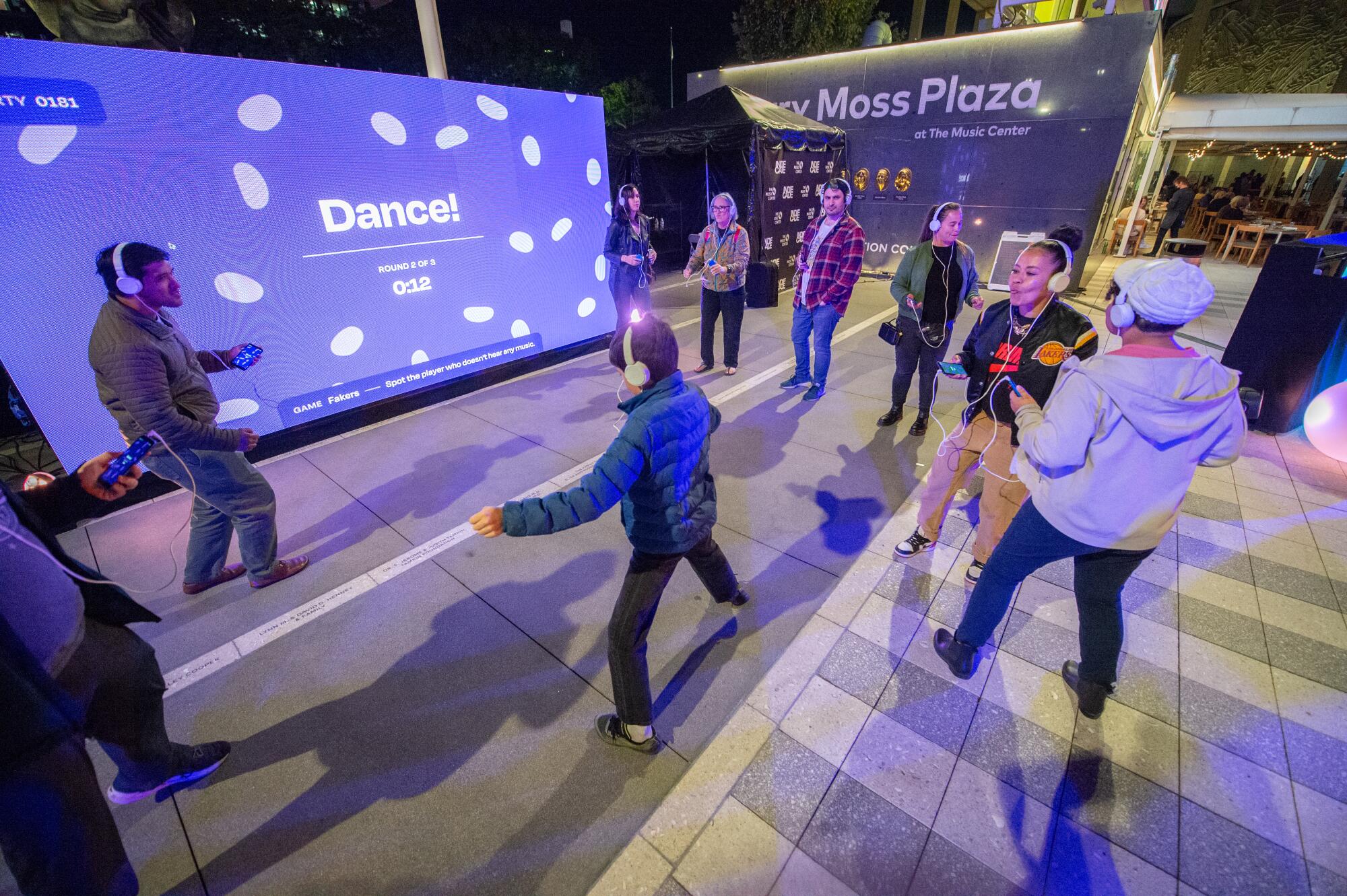
IndieCade often features participatory, communal games, such as “Secret Shuffle” at last year’s event.
(Scott Chamberlin / IndieCade)
The event is arriving at a difficult time for the game industry. In 2023, at least 6,500 game workers worldwide were laid off, according to a Times analysis, including hundreds at California-based companies like Unity and Riot Games. The cuts have continued into 2024. The state of the industry is sure to be a topic at IndieCade’s developer focused two day Creator’s Retreat at downtown’s ASU California Center. IndieCade architects, however, are pitching the festivities as a sort of creative rejuvenation.
“When the big studios fall apart, the people that are still making games — if they want to keep making games — want to be a part of this community,” Barish says. “When the industry feels like it’s being shaken up, this is the heart — the creativity, the connection and the new ideas. These are the things that will most likely drive the industry forward. It’s going to be the innovations coming from unexpected places. That’s our mission. To bring people together to keep the creative spark going.”
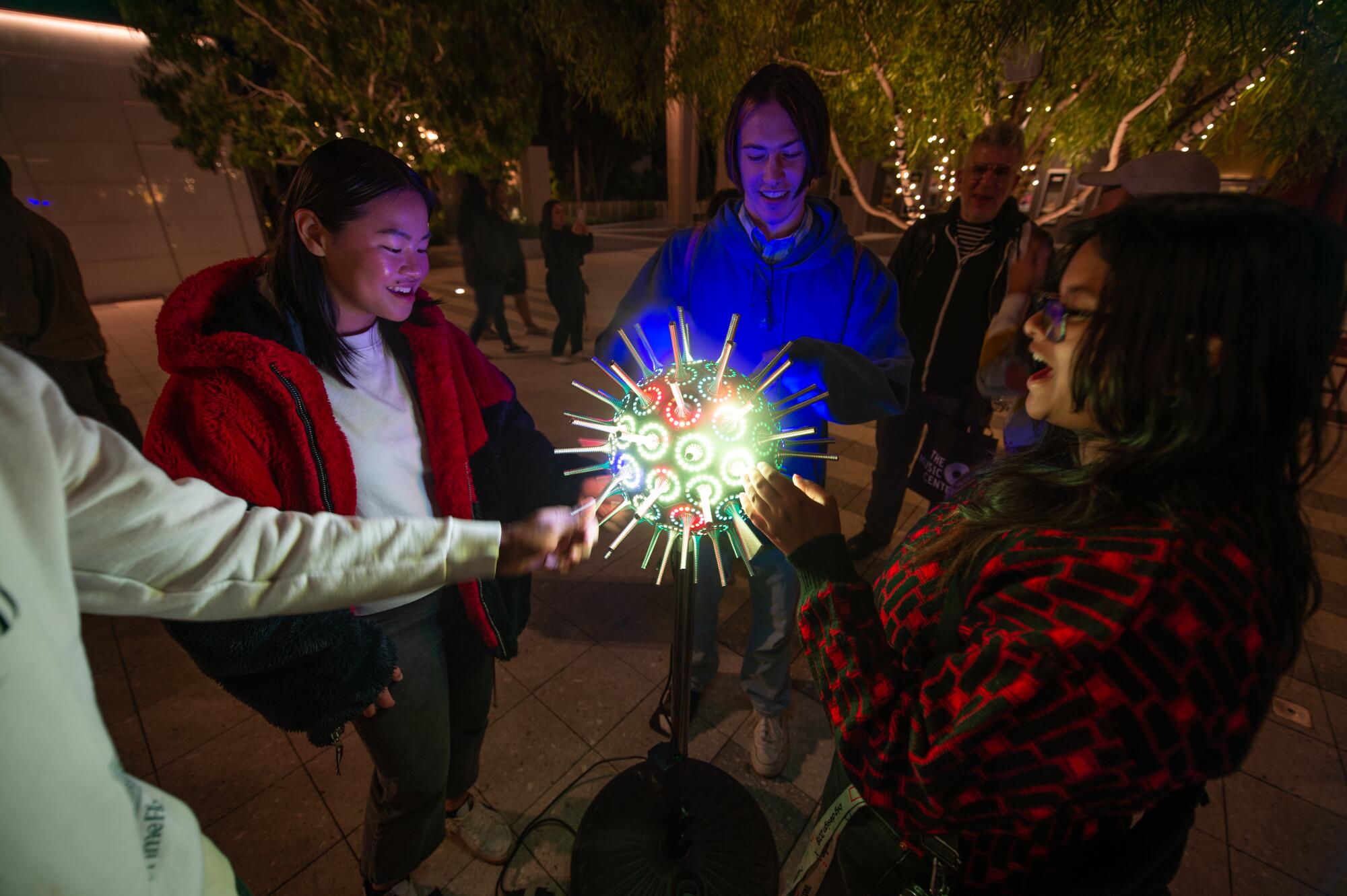
Guests at last year’s Night Games at downtown’s Music Center experience an experimental game, “Wobble Sphere.”
(Scott Chamberlin / IndieCade)
And few places in gaming are as unpredictable as an IndieCade event. There’s nowhere else, for instance, one can sample a “Teenage Mutant Ninja Turtles” game and take part in the live-action role-playing game “The Apple Avenue Detective Agency.” The latter, from husband and wife duo Mister & Mischief, takes its cues from works such as “Encyclopedia Brown” and “Nancy Drew,” casting adults in the role of kid detectives. It’s inspired by the real-life childhood games of co-creator Andy Crocker, who’s made it sort of a mission to have grown-ups reconnect with their younger selves.
“While the show is about childhood, it is truly not designed for kids,” writes Crocker via email. She designed the experience with her husband, Jeff. “The further away from childhood we get, the more support we need to access our imagination and wonder.”
Crocker adds that the power of being a kid detective comes not from where you are, but how you see the world: “A kid detective can notice details and cultivate curiosity anywhere — all you need are a few friends. And snacks. A notebook is helpful. Also a magnifying glass and some walkie talkies. But mostly friends.”
Likely, at IndieCade, friends you just met.
